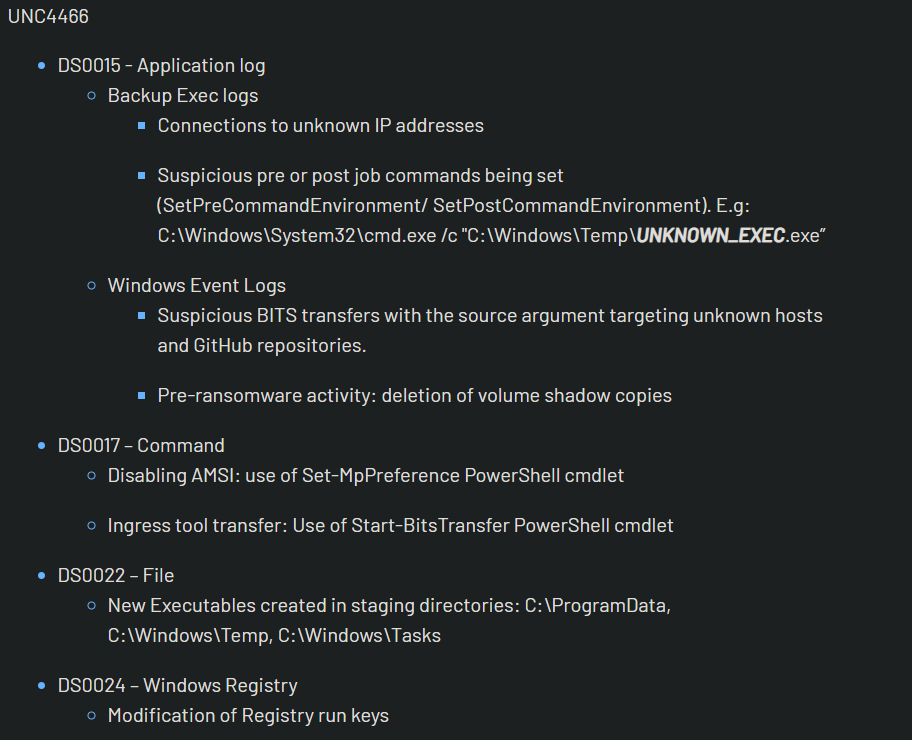April 7, 2023 CISA KEV Breakdown | Veritas, Microsoft, Arm

April 7 – 5 New Vulns | CVE-2019-1388, CVE-2021-27876, CVE-2021-27877, CVE-2021-27878, CVE-2023-26083
In this CISA KEV Breakdown, 5 vulnerabilities were added, 3 of them from Veritas related to an exploit-chain in their Backup Agent, a Windows vulnerability found in the Certificate Dialog, and finally Arm’s Mali GPU kernel containing kernel information-leakage.
Notable Vulnerability Additions
CVE-2021-27876, CVE-2021-27877, CVE-2021-27878 | Veritas Backup Exec Agent Exploit Chain
A vulnerability exploit-chain was uncovered in Veritas Backup Exec Agent before version 21.2 when Mandiant-tracked actor UNC4466 used the vulnerabilities to gain initial access and elevated privilege to their target network. The actor has typically been observed utilizing stolen credentials as a means for initial access and elevation of privilege, suggesting a shift to opportunistic targeting of known vulnerabilities. Read more from Mandiant’s report here. Organizations should prioritize ensuring that any internet-exposed Veritas Backup Windows installations before version 21.2 is properly monitored and limited in access.
Security Advisory:
https://www.veritas.com/support/en_US/security/VTS21-001
CVE-2023-26083 | ARM Mali GPU Kernel Information Leakage
Referenced many times in our March 30 CISA KEV Breakdown post, a vulnerability discovered in ARM Mali GPU Kernel was utilized by spyware actors to exploit Samsung and Android phones. This particular vulnerability was one of the more recently-discovered vulnerabilities bundled up by Google’s Threat Analysis Group (TAG) in their report about two separate spyware campaigns targeting Android and Apple phones. Now that Arm has posted guidance on the remediation of CVE-2023-26083, it has been added to the KEV.
Security Advisory:
https://developer.arm.com/Arm%20Security%20Center/Mali%20GPU%20Driver%20Vulnerabilities
← April 03, 2023 CISA Kev Breakdown
Click here to expand our CISA KEV Breakdown Frequently Asked Questions
- What makes for a notable addition?
- A notable addition can arise from many different characteristics. If a particular vulnerability is notable to the security community or a subset of the security community or if the EPSS score reveals notable information about the vulnerability, this can constitute further analysis. It may also be the case that a particular vulnerability shines a light on everyday users and we will highlight important information and key takeaways to ensure users and readers have easy access to actionable information.
- When is the Breakdown released?
- We aim to have our analysis of each KEV update posted within 24 hours of the time in which the Catalog is updated. See CISA’s full catalog here
- I am not bound by BOD 22-01 or federal regulations, why should the KEV concern me?
- CISA encourages all organizations to utilize the Catalog as an attribute in your vulnerability prioritization framework. Organizations looking to lessen the scope on known dangerous vulnerabilities and make a goal to remediate them can understand where they currently stand against what CISA has confirmed as exploited vulnerabilities in the wild. See CISA’s section on “How should organizations use the KEV catalog?” here.
- What is EPSS?
- EPSS is the Exploit Prediction Scoring System. It is an open, data-driven effort for estimating the likelihood (probability) that a software vulnerability will be exploited in the wild. See the EPSS home page on FIRST for more information here.
- What is the difference between EPSS probability and EPSS percent?
- EPSS probability is the risk calculated by the model when determining the perceived threat of the vulnerability itself. Percentage is a relative comparison of the rest of the CVEs within the given sample. While the probability only changes upon refreshing the results from the model, the percentage can change purely based on the CVE sample given. In the case of the Breakdown, we use the percentage given by the pool of all CVEs with given EPSS data. Scores may vary post-release of the post given new information about the vulnerabilities and their perceived threat. For more information on applying and understanding EPSS data, see this article on the FIRST website, as well as their FAQ page.
- What is GreyNoise?
- GreyNoise is a platform that collects, analyzes, and labels data on IPs that scan the internet and saturate security tools with noise. Through their sensor network, GreyNoise observes vulnerability exploitation attempts for vulnerabilities that are exploited in the wild over the Internet. These are arguably vulnerabilities that should be at the very top of your priority list to remediate.
- Why are GreyNoise exploitation attempts only observed on ~20% of KEV vulnerabilities?
- Exploitation of many vulnerabilities in the CISA KEV will not be observed for many reasons that GreyNoise does a good job of explaining in this post. For example:
- The vulnerability may not be remotely exploitable
- Vulnerability exploitation may require authentication (and result in privilege escalation)
- The impacted software may not be exposed to the internet
- Mass scanning/exploitation is not occurring yet
- Exploitation of many vulnerabilities in the CISA KEV will not be observed for many reasons that GreyNoise does a good job of explaining in this post. For example:
See Nucleus in Action
Discover how unified, risk-based automation can transform your vulnerability management.































